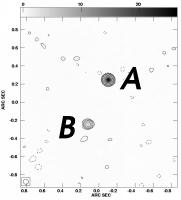Lens System Summary
This double-image lens has significantly extended, weak VLBA substructure. NICMOS shows the two images and the lensing galaxy. Predictions from modelling suggest that the time delay between the images is too small to be effectively monitored (7 h-1 days). This lens is not in the CLASS complete sample because it is too faint at 5GHz.
|
This Lens System
|
Lens name
|
B0739+366
|
|
Survey
|
CLASS
|
|
Images
|
2
|
|
B1950.0 coords
|
07h39m32.507s
|
36°41'51.880"
|
|
J2000.0 coords
|
07h42m51.169s
|
36°34'43.638"
|
|
Lens System Structure and Labelling
Image labelling for this lens (RA increases to the left, declination increases upwards)

|
Image/Lens Positions
|
Image/Lens
|
Relative Position
|
|
East (mas)
|
North (mas)
|
|
A1
|
+0.0
|
+0.0
|
|
A2
|
+2.4
|
+1.0
|
|
B
|
+221.7±1
|
-491.0±1
|
|
Image/Lens Separations
|
Separation (mas)
|
|
Component
|
A1
|
A2
|
B
|
|
A1
|
|
2.6
|
538.7
|
|
A2
|
2.6
|
|
538.7
|
|
B
|
538.7
|
538.7
|
|
|
Position angle (°)
|
|
Component
|
A1
|
A2
|
B
|
|
A1
|
|
-112.6
|
-24.3
|
|
A2
|
67.4
|
|
-24.0
|
|
B
|
155.7
|
156.0
|
|
|
Maps and Images
Click on an image to see a larger JPEG version, or click on the accompanying text to
download a gzipped FITS or PostScript file of the map or image. The images and maps are
available in one gzipped file here.
To see a DSS image of the region around this lens, click here - note that you will have to start the search manually by clicking on the 'Search' button.
|
Radio Flux Densities
|
Component
|
Flux density (mJy)
|
|
1.7 GHz
|
5 GHz
|
5 GHz
|
5 GHz
|
5 GHz
|
8.4 GHz
|
8.4 GHz
|
15 GHz
|
|
A
|
Detected
|
|
6.9X
|
Detected
|
26.8
|
21.7
|
20.3
|
19.1
|
|
A1
|
"
|
29.0
|
|
|
|
|
|
|
|
A2
|
"
|
2.1
|
|
|
|
|
|
|
|
B
|
"
|
6.2
|
X
|
"
|
4.9
|
3.4
|
3.8
|
2.8
|
|
Flux errors
|
|
10%
|
|
|
10%
|
10%
|
10%
|
10%
|
|
Resolution (mas)
|
7.7x5.4
|
3.8x1.5
|
50
|
50
|
200
|
200
|
200
|
200
|
Map noise level
(mJy/beam)
|
0.045
|
0.11
|
|
|
|
|
|
|
|
Instrument
|
VLBA
|
VLBA
|
MERLIN
|
MERLIN
|
VLA
|
VLA
|
VLA
|
VLA
|
|
Date observed
|
1999/08/29
|
1997/08/07
|
1996/12/27
|
1998/12/4
|
1999/08/30
|
1995/08/13
|
1999/08/30
|
1999/08/30
|
|
Reference
|
[1]
|
[1]
|
[1]
|
[1]
|
[1]
|
[1]
|
[1]
|
[1]
|
|
Sub-millimetre Flux Densities
|
Component
|
Flux density (mJy)
|
|
1300 μm
|
850 μm
|
450 μm
|
|
Total
|
<2.8
|
6.6±1.3
|
36±8
|
Estimated
cal. error
|
|
5-10%
|
5-10%
|
|
Instrument
|
IRAM 30-m
|
SCUBA (JCMT)
|
SCUBA (JCMT)
|
|
Date observed
|
|
1999-2001
|
1999-2001
|
|
Reference
|
[2]
|
[2]
|
[2]
|
|
Optical Imaging
|
Component
|
Brightness (Magnitudes)
|
|
F160W (H)
|
|
A
|
19.0
|
|
B
|
21.7
|
|
Lensing galaxy
|
21.7
|
|
Instrument
|
NICMOS (HST)
|
|
Integration time
|
|
|
PSF size (arcsec)
|
|
|
Pixel scale (mas/pixel)
|
43
|
|
Date observed
|
1998/04/10
|
|
Reference no.
|
[1]
|
|
Lens Models
Click on the model's reference number to go to the relevant paper's abstract on ADS.
[1] Marlow et al. fixed SIE to point of peak surface brightness in NICMOS image. Constraints from VLBA unused since substructure is weak and heavily resolved. Suggests time delay between images A and B of 7 h-1 days, i.e. probably too short for effective monitoring.
|
Notes
VLBA substructure consists of very weak and significantly extended jets. Difficult to constrain mass models using these.
No redshifts available for this system as yet.
It's likely that the time delay is too short to be properly monitored.
|
References
Click here to see the CASTLES data available for this object, or here to search for references on NED. You can go to a paper's abstract on ADS by clicking its reference number.
-
[1] CLASS B0739+366: A new two-image gravitational lens system, D. R. Marlow et al., Astron. J. vol. 121, p. 619 (2001)
-
[2] A submillimeter survey of gravitationally lensed quasars, R. Barvainis and R. Ivison, Astrophys. J. 571, pp. 712-720 (2002)
|
Click here to go back to the database index page, or here to go back to the top of this page. |
